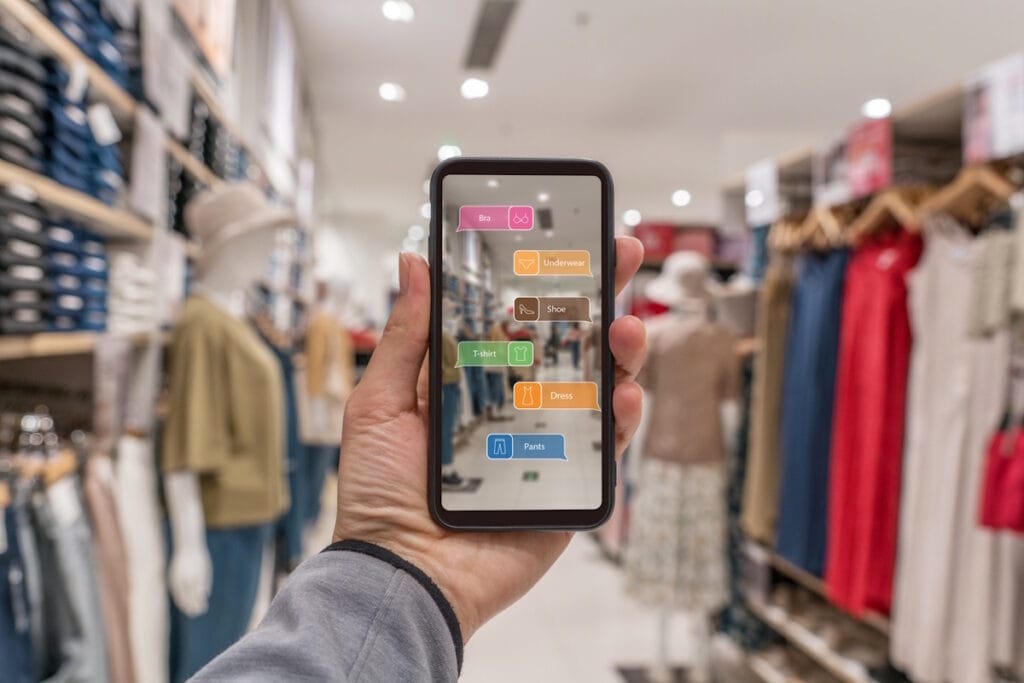Voice assistants (Siri, Alexa, Google Assistant) are rapidly changing how customers shop. Today roughly 20% of global searches are voice-basedyaguara.co, and in the US about 150 million people use voice assistantsyaguara.co. Voice commerce is booming – worldwide voice shopping jumped from $4.6 billion in 2021 to nearly $20 billion in 2023 (a ~400% increase)blog.clover.com, and surveys show ~28% of consumers have bought products by voiceinvoca.com. Consumers use voice to shop for convenience, local info, and quick reorders. For brands, this means capturing voice-driven traffic by tuning content, technical setup, and product data specifically for spoken queries.
Optimizing for voice search means focusing on natural language Q&A and structured data (illustrated). This image highlights key elements like “Mobile Experience,” “Customer Reviews,” “FAQ Pages,” and “Structured Data” – all vital for getting your store’s products found and featured by voice assistants.
Voice queries are conversational and question-based. For example, instead of “running shoes sale,” users might ask, “Hey Google, where can I buy comfortable running shoes for women?”mytotalretail.com. Voice assistants typically read a single answer aloud, usually drawn from a featured snippet or a concise FAQ on your sitenogood.ioappnova.com. To win that spot, optimize product pages and content for natural language and question/answer format. Write content in a friendly, conversational tone and include actual questions as headings or bullet lists. Aim to answer each question in one succinct paragraph (around 30 words) or a list so it matches the short, precise answers Google prefersnogood.iomytotalretail.com.
- Use conversational phrases and long-tail keywords: Rewrite titles and descriptions to mirror how people speak. For example, change “women’s yoga pants” to content that answers “what are the best yoga pants for hot yoga?” or “women’s breathable yoga leggings.” This aligns your pages with spoken queriesnogood.iomytotalretail.com.
- Build FAQ/Q&A content: Add an FAQ or Q&A section on your site (or dedicated pages) that directly answers common customer questions. Use “Who, What, Where, When, Why, How” phrasing. Google’s voice assistant will often read these snippets. Research actual queries via tools like AnswerThePublic or Google’s “People also ask” and answer them clearly.
- Leverage customer reviews: Encourage detailed reviews on your site and third-party platforms. Reviews contain natural language that often matches voice queries. Voice algorithms use reviews to gauge product quality, and assistants frequently highlight products with high ratings and may read review snippetsnogood.io. For example, if many reviews praise your “waterproof hiking boots,” a voice assistant might cite that when asked about hiking boots.
Use Structured Data (Schema) to Guide Voice Assistants
Voice engines rely on structured data to find and read content. Implement relevant Schema markup across your site: Product schema (with price, availability, ratings), FAQPage and QAPage schema for FAQs, HowTo schema (if you have instructional content), and LocalBusiness schema if you have physical stores. Crucially, use Google’s Speakable schema (still in beta) to mark sections of page text that are ideal for audio playbackappnova.com. This tells Google which paragraphs or list items to read aloud for news or blog content. Adding rich snippets for your products, reviews, and FAQs makes it much easier for voice assistants to pull direct answers from your siteappnova.comnogood.io.
- FAQ Schema: Tag your Q&A content with FAQPage schema. Google can then surface these Q&As directly in voice results.
- Product & Review Schema: Ensure each product page has structured data including title, description, price, availability, and aggregateRating. Voice assistants use this data to confirm details before suggesting a purchase.
- Speakable Markup: If you publish news or blog content, use speakable schema to flag the key paragraphs you want assistants to read. Google’s documentation and tools can help implement JSON-LD for Speakable sections (e.g. intro paragraphs).
- Local Schema: If you have retail locations, use LocalBusiness schema with correct NAP (Name, Address, Phone). Voice search often includes “near me” queries, so up-to-date location data is criticalappnova.com.
Ensure Fast, Mobile-Friendly Performance
Most voice searches happen on mobile devices. If your store is slow or not mobile-optimized, Google’s algorithms will skip it. Audit your site’s speed (use Google PageSpeed Insights, Lighthouse) and fix any issues: compress images, use a CDN, enable caching, and use a mobile-responsive theme or template. Shopify and WordPress have built-in optimizations, but additional speed plugins (e.g. WP Rocket, NitroPack) or lightweight frameworks can help. Google explicitly warns that slow pages won’t be chosen for voice responses. Also ensure secure (HTTPS) and accessible design, since voice assistants prefer secure, well-structured sites. In short, a clean, fast site gives you a shot at voice rankings.
Focus on Local SEO for “Near Me” Queries
Voice queries often have local intent (restaurants, stores, services). In fact, ~58% of voice searches are for local business info. If you have any retail locations or local delivery, prioritize your Google Business Profile: verify it, keep hours/address/phone updated, and encourage positive Google reviews. Include city or neighborhood names organically in your content (e.g. “New York coffee delivery”) rather than keyword-stuffing. Also populate your site with location-specific FAQ and About sections. For example, add a “Store Hours” FAQ that voice assistants can read out. Since voice search often prompts a call or directions, make sure your contact info is prominent.
Integrate Voice Shopping and On-Site Voice Search
Beyond SEO, e-commerce brands can offer voice shopping experiences. Major retailers and brands are already doing this: Domino’s, Walmart, and Sephora all let customers order via voice. On Amazon, brands can enable Alexa reordering or build a custom Alexa Skill; on Google Assistant, you can create an Action that adds items to cart (Walmart’s voice cart uses Google Assistant). For Shopify and other platforms, consider voice-search plugins and chatbot apps that let users search your catalog by speaking.
- Shopify Voice-Search Apps: Tools like Searchanise, Doofinder, or Expertrec add a voice-enabled search bar to your store. For example, Searchanise’s app supports “Voice search & personalized AI” (it recognizes spoken product queries), and Doofinder offers “Voice & visual search for any device”. Installing such apps makes it easier for customers with Alexa/Siri on their phones to search your site hands-free.
- Alexa and Assistant Skills: If you have development resources, use Amazon’s Alexa Skills Kit (Shopping and Transactions APIs) and Google’s Actions API to build a voice shopping skill for your store. This allows users to ask Alexa or Google to search your store, add to cart, and even complete checkout. Tools like Voiceflow can simplify building voice apps without heavy coding. Even without a full skill, enabling “Buy with Alexa” on Amazon products or Google voice shopping integration can boost orders.
- Voice Commerce Best Practices: Make sure voice checkout is seamless. Pre-load user preferences (saved addresses, payment methods). Use clear voice prompts and confirmations (don’t finalize an order without confirmation). After a voice order, follow up with a notification or email for security.
By embracing voice commerce channels and traditional SEO, you capture both voice-savvy shoppers and casual searchers. Note that voice assistants are integrating with other interfaces too: Google Lens (visual search) and smart devices (TVs, cars) often work with voice, so think beyond the website.
Measure and Optimize for Voice
Tracking voice search isn’t straightforward, but you can infer it with analytics and SEO tools. In Google Search Console, filter your query data for question-like keywords (queries starting with “how,” “where,” “best,” etc., or containing prepositions like “in” or “for”). These are likely voice queries. Use Google Analytics to see if pages optimized for questions (FAQs, guides) get increased traffic over time. Monitor rankings for featured snippets – since voice results often come from snippet content. Tools like SEMrush or Ahrefs can help: find keywords where you rank in the top 5 but lack a snippet, then refine those pages to capture the “position zero” answer.
Also watch voice-specific KPIs: smart speaker sales (Statista predicts 75% of households will own one by 2025), and on-site engagement from voice-search-enabled sessions (some analytics can identify traffic with voice-assistant user agents). Regularly test your own voice experience: ask your phone or smart speaker to find your product or content and note if the answer comes from your site or a competitor.
Tactical Voice SEO Checklist
- Conversational Content: Rewrite titles/descriptions using question phrases (e.g. “Where can I find X?”). Add FAQ sections with concise answers (30 words or less). Include question words (who, what, where, how) in headings.
- Structured Data: Add schema for FAQPage, Product, Review, and (if applicable) LocalBusiness, HowTo, Speakable. Use Google’s Rich Results Test to validate your markup.
- Optimize for Snippets: Identify high-impact question keywords (use AnswerThePublic, AlsoAsked, Google “People also ask”). Target and improve content where you rank well or could rank in featured snippets.
- Mobile & Speed: Ensure pages load in <3 seconds. Compress images, enable AMP (if feasible), and use a responsive, light theme. Test regularly with PageSpeed Insights and fix any “mobile usability” issues.
- Local Presence: Keep your Google Business Profile up-to-date (hours, address, phone). Populate it with FAQs and photos. Encourage satisfied customers to leave Google Reviews.
- On-Site Voice Search: Install a voice-enabled search app (e.g. Searchanise, Doofinder) so site visitors can use voice queries.
- Voice Commerce: Explore Amazon and Google voice shopping. Set up an Alexa Skill or Google Action for your store, or leverage any available voice purchase features (e.g. Alexa “reorder” settings)
- Review Monitoring: Track and respond to product reviews on all channels (site, Google, Amazon). Highlight positive reviews in your product descriptions.
- Performance Tracking: Use Search Console and analytics to watch for growth in question/query traffic. Adjust your content and schema based on what voice queries are working.
Voice search is now a mainstream channel. By strategically structuring content, data, and tech for spoken queries, e-commerce brands can tap a growing stream of high-intent customers. The brands who answer questions “out loud” in the same natural way people ask them – with clear, structured answers – will dominate voice search and capture those easy, hands-free conversions



